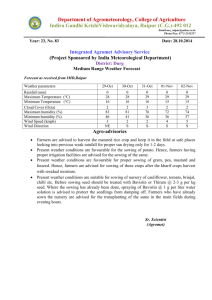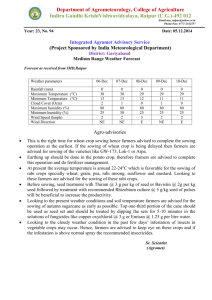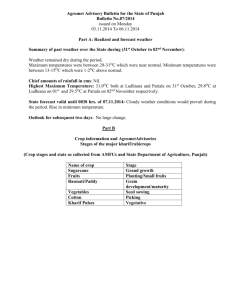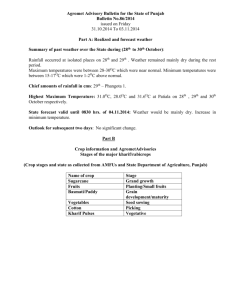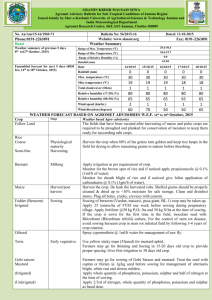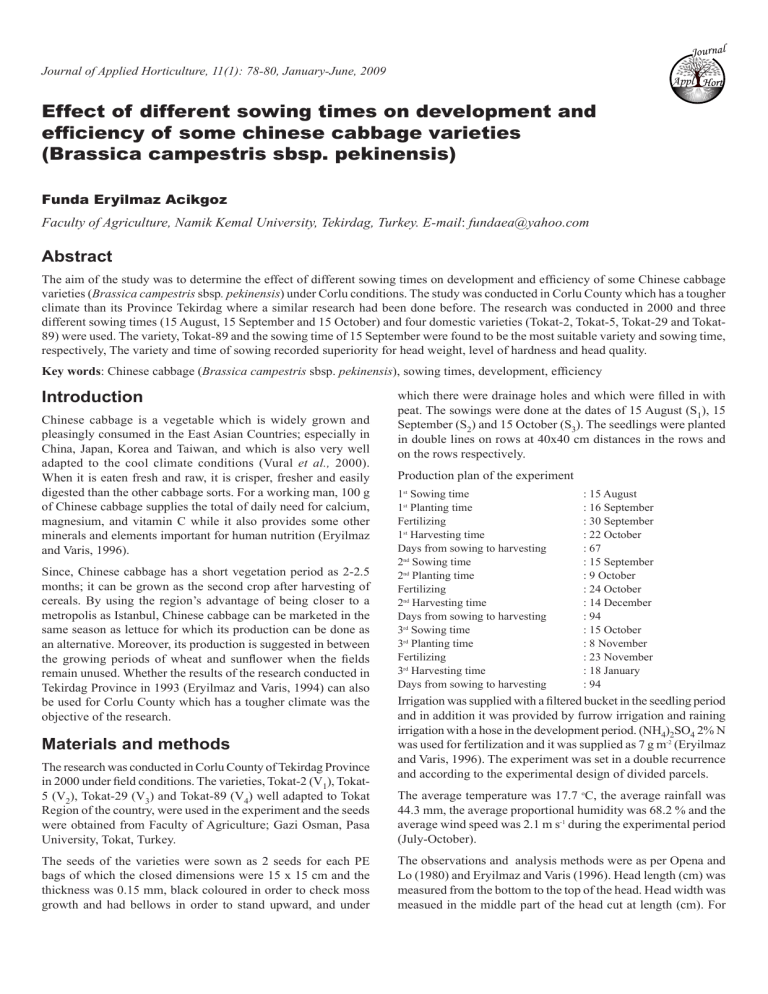
Journal Journal of Applied Horticulture, 11(1): 78-80, January-June, 2009 Appl Effect of different sowing times on development and efficiency of some chinese cabbage varieties (Brassica campestris sbsp. pekinensis) Funda Eryilmaz Acikgoz Faculty of Agriculture, Namik Kemal University, Tekirdag, Turkey. E-mail: fundaea@yahoo.com Abstract The aim of the study was to determine the effect of different sowing times on development and efficiency of some Chinese cabbage varieties (Brassica campestris sbsp. pekinensis) under Corlu conditions. The study was conducted in Corlu County which has a tougher climate than its Province Tekirdag where a similar research had been done before. The research was conducted in 2000 and three different sowing times (15 August, 15 September and 15 October) and four domestic varieties (Tokat-2, Tokat-5, Tokat-29 and Tokat89) were used. The variety, Tokat-89 and the sowing time of 15 September were found to be the most suitable variety and sowing time, respectively, The variety and time of sowing recorded superiority for head weight, level of hardness and head quality. Key words: Chinese cabbage (Brassica campestris sbsp. pekinensis), sowing times, development, efficiency Introduction Chinese cabbage is a vegetable which is widely grown and pleasingly consumed in the East Asian Countries; especially in China, Japan, Korea and Taiwan, and which is also very well adapted to the cool climate conditions (Vural et al., 2000). When it is eaten fresh and raw, it is crisper, fresher and easily digested than the other cabbage sorts. For a working man, 100 g of Chinese cabbage supplies the total of daily need for calcium, magnesium, and vitamin C while it also provides some other minerals and elements important for human nutrition (Eryilmaz and Varis, 1996). Since, Chinese cabbage has a short vegetation period as 2-2.5 months; it can be grown as the second crop after harvesting of cereals. By using the region’s advantage of being closer to a metropolis as Istanbul, Chinese cabbage can be marketed in the same season as lettuce for which its production can be done as an alternative. Moreover, its production is suggested in between the growing periods of wheat and sunflower when the fields remain unused. Whether the results of the research conducted in Tekirdag Province in 1993 (Eryilmaz and Varis, 1994) can also be used for Corlu County which has a tougher climate was the objective of the research. Materials and methods The research was conducted in Corlu County of Tekirdag Province in 2000 under field conditions. The varieties, Tokat-2 (V1), Tokat5 (V2), Tokat-29 (V3) and Tokat-89 (V4) well adapted to Tokat Region of the country, were used in the experiment and the seeds were obtained from Faculty of Agriculture; Gazi Osman, Pasa University, Tokat, Turkey. The seeds of the varieties were sown as 2 seeds for each PE bags of which the closed dimensions were 15 x 15 cm and the thickness was 0.15 mm, black coloured in order to check moss growth and had bellows in order to stand upward, and under which there were drainage holes and which were filled in with peat. The sowings were done at the dates of 15 August (S1), 15 September (S2) and 15 October (S3). The seedlings were planted in double lines on rows at 40x40 cm distances in the rows and on the rows respectively. Production plan of the experiment 1st Sowing time 1st Planting time Fertilizing 1st Harvesting time Days from sowing to harvesting 2nd Sowing time 2nd Planting time Fertilizing 2nd Harvesting time Days from sowing to harvesting 3rd Sowing time 3rd Planting time Fertilizing 3rd Harvesting time Days from sowing to harvesting : 15 August : 16 September : 30 September : 22 October : 67 : 15 September : 9 October : 24 October : 14 December : 94 : 15 October : 8 November : 23 November : 18 January : 94 Irrigation was supplied with a filtered bucket in the seedling period and in addition it was provided by furrow irrigation and raining irrigation with a hose in the development period. (NH4)2SO4 2% N was used for fertilization and it was supplied as 7 g m-2 (Eryilmaz and Varis, 1996). The experiment was set in a double recurrence and according to the experimental design of divided parcels. The average temperature was 17.7 oC, the average rainfall was 44.3 mm, the average proportional humidity was 68.2 % and the average wind speed was 2.1 m s-1 during the experimental period (July-October). The observations and analysis methods were as per Opena and Lo (1980) and Eryilmaz and Varis (1996). Head length (cm) was measured from the bottom to the top of the head. Head width was measued in the middle part of the head cut at length (cm). For The effect of different sowing times on development and efficiency of some chinese cabbage varieties 79 Table 1. The effect of sowing times on average head weight in some Chinese cabbage varieties (g) Sowing Times Tokat-2 Tokat-5 Tokat-29 15 August 1070.0 1475.0 1326.5 15 September 1470.0 1532.0 1610.0 15 October 1500.0 1200.0 1100.0 Main variety effect 1346.6 1402.3 1345.1 Tokat-89 1375.0 1600.0 1300.0 1425.0 Main Sowing Effect 1311.6AB 1553.0A 1275.0B 1379.8 LSD for Main Sowing Effect: LSD (P=0.01)=192.7 Table 2. The effect of sowing times on the ratio of tight head in some Chinese cabbage varieties (%) Sowing Times Tokat-2 Tokat-5 Tokat-29 15 August 63.0 71.0 56.5 15 September 62.0 58.0 57.5 15 October 51.5 60.0 43.0 Main variety effect 58.8 63.0 52.3 Tokat-89 68.0 43.0 60.0 57.0 Main Sowing Effect 64.6A 55.1AB 53.6B 57.7 LSD for Main Sowing Effect: LSD (P=0.01) = 11.2 number of leaves, all leaves were counted and averaged. For head weight plant head weight with outer leaves was measured after harvesting. Heading efficiency was calculated by dividing mean head weight with non-wrapper leaf weight. obtained among the sowing times with respect to the averages. There was no significant difference within the varieties. However, Tokat-29 gave the highest percentage of not forming head plant (Table 4). For head tightness, all plants were observed and evaluated after each harvesting and they were explained as tight head, loose head and not forming head by (%). Hardness was determined by using following formula: Hardness (g cc-1) = Average head weight head volume -1. Where, Head volume (cc) = 0.524(d12 d2-1), d1 = Average Head width (cm), d2 = Average head length (cm). Hardness: The hardness of the varieties ranged from 0.39-0.42 (Table 3). The higher the hardness is, the tighter the head will be and this is a desirable property, because the paleness is attained later in plants with tight head. There was an excess weight in the plants which have smaller volume and they are comfortably and profitably marketed (Yazgan and Edizer, 1987). Moreover, a high value of hardness is advantageous for the producer, carrier, marketer and consumer due to enduring (Yazgan and Ece, 1990). Results and discussion Head weight: Analyis of variance for testing effect of variety and sowing time on head weigh revealed that the mean sowing effect was significant at P=0.01 for head weight and sowing time of 15 September gave the plant with the heaviest head (Table 1). Tight head: Analysis of variance indicated that the main sowing effect was significant at P=0.01 for the tightness of head. Consequently, the sowing time of 15 August gave the tightest head (Table 2). Tight head is an important factor for Chinese cabbage because of easy marketing (Gercekcioglu and Yazgan, 1989). Loose head: Analysis of variance revealed that the sowing time was important for loose head formation. Thus, the sowing time of 15 October gave the plants having the loose heads. Percentage of not forming head: The number of plants which did not form head was quite low. Hence, variance analysis was not realised. From the sowing time of 15 August, 7.4 % and from the sowing time 15 October 20 % of not forming head plants were Table 3. Hardness in Chinese cabbage varieties Variety Tokat-2 Tokat-5 Tokat-29 Tokat-89 Hardness (g cc-1) 0.39 0.40 0.40 0.42 The results of the research are given as a whole in Table 4. For Corlu conditions; the variety of Tokat-89 and the sowing time of 15 September were determined as the most convenient variety and sowing time, respectively, regarding: head weight, level of hardness and head quality. References Eryilmaz, F. and S. Varis, 1994. The effect of different sowing times on development and efficiency in some Chinese cabbage varieties. The J. Trakya Univ., 3(1-2): 1-8. Eryilmaz, F. and S. Varis, 1996. The effect of different sowing times on Table 4. The results of the criteria analysed (S: sowing time; V: variety) Treatment Head length Head width Number of Head weight Seed forming (cm) (cm) leaves (g) head (%) S 1V 1 23.8 15.8 36 1070.0 0 S 1V 2 22.0 18.3 30 1475.0 0 S 1V 3 24.0 16.7 33 1326.5 0 S 1V 4 23.2 15.9 30 1375.0 0 S 2V 1 26.2 16.1 33 1470.0 0 S 2V 2 24.3 16.7 35 1532.0 0 27.4 15.2 33 1600.0 0 S 2V 3 S 2V 4 28.2 16.4 34 1610.0 0 S 3V 1 25.5 16.3 40 1500.0 0 S 3V 2 22.8 15.8 42 1200.0 0 S 3V 3 23.4 16.1 33 1100.0 0 25.2 15.2 38 1300.0 2 S 3V 4 Tight head ratio (%) 63 71 56.5 68 62 58 43 57.5 51.5 60 43 60 Loose head ratio (%) 37 30 43 42 38 41 43 32 30 17 20 15 Not forming head (%) 0 0 0 0 0 4 11 14 18 23 35 25 Heading efficiency 21400 29500 26530 27500 29400 30640 32000 32200 30000 24000 22000 26000 80 The effect of different sowing times on development and efficiency of some chinese cabbage varieties development and efficiency in some Chinese cabbage varieties. The Project of South-eastern Anatolia (GAP) 1st Agriculture of Vegetables Symposium: 106-112, 7-10 May, 1996, Sanlıurfa, Turkey. Gercekcioglu, R. and A.Yazgan, 1989. A research on determining the convenient Chinese cabbage varieties (Brassica campestris L. Ssp. pekinensis Lour Olsson) for Tokat region’s fall season. Doga TU Tar. ve Or., 13(2): 255-264. Opena, R.T. and S.H. Lo, 1980. Procedure for Chinese cabbage evaluation trials. International Co-operator’s Guide, AVRDC 80144, 6. Vural, H., D. Esiyok and I. Duman, 2000. Culture Vegetables (Vegetables Growing), Ege University Prints, Izmir, Turkey. p 23-129. Yazgan, A. and Y. Edizer, 1987. The determination of Chinese cabbage varieties (Brassica campestris L. Ssp. pekinensis Lour Olsson) convenient to be grown in Tokat Province’s spring and summer. The Journal of Cumhuriyet University Faculty of Agriculture, 6(1): 127-149. Yazgan, A. and A. Ece, 1990. The adaptation of Chinese cabbage variety nominees Tokat-2, Tokat-5, Tokat-29 ve Tokat-89 in Tokat conditions. The Journal of Cumhuriyet University Faculty of Agriculture, 6(1): 439-449.
